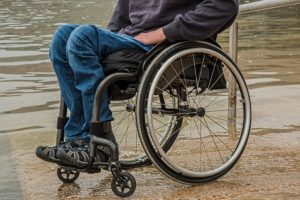Human trials in the works to help the paralyzed walk again

Spinal cord injuries were previously thought untreatable. Now, with proof of concept in primates, the research is ready to move forward to human trials. Rats and monkeys with spinal cord injuries were not able to walk. By implanting electrodes on the brain, then implanting electrodes distal to the spinal cord injury, the circuitry allows the nervous system to bypass the area of injury and it allowed the injured animals to walk again. This is a very exciting breakthrough for those suffering trauma.
The Research
A brain–spine interface alleviating gait deficits after spinal cord injury in primates
Marco Capogrosso 1,2 *, Tomislav Milekovic 1 *, David Borton 1,3 *, Fabien Wagner 1
, Eduardo Martin Moraud 2 , Jean-Baptiste Mignardot 1 , Nicolas Buse 4 , Jerome Gandar 1 , Quentin Barraud 1 , David Xing 3 , Elodie Rey 1 , Simone Duis 1 , Yang Jianzhong 5 , Wai Kin D. Ko 5 , Qin Li 5,6 , Peter Detemple 7 , Tim Denison 4 , Silvestro Micera 2,8 , Erwan Bezard 5,6,9,10 , Jocelyne Bloch 11 & Grégoire Courtine
Spinal cord injury disrupts the communication between the brain and the spinal circuits that orchestrate movement. To bypass the lesion, brain–computer interfaces have directly linked cortical activity to electrical stimulation of muscles, and have thus restored grasping abilities after hand paralysis. Theoretically, this strategy could also restore control over leg muscle activity for walking. However, replicating the complex sequence of individual muscle activation patterns underlying natural and adaptive locomotor movements poses formidable conceptual and technological challenges. Recently, it was shown in rats that epidural electrical stimulation of the lumbar spinal cord can reproduce the natural activation of synergistic muscle groups producing locomotion. Here we interface leg motor cortex activity with epidural electrical stimulation protocols to establish a brain–spine interface that alleviated gait deficits after a spinal cord injury in non-human primates. Rhesus monkeys (Macaca mulatta) were implanted with an intracortical microelectrode array in the leg area of the motor cortex and with a spinal cord stimulation system composed of a spatially selective epidural implant and a pulse generator with real-time triggering capabilities. We designed and implemented wireless control systems that linked online neural decoding of extension and flexion motor states with stimulation protocols promoting these movements. These systems allowed the monkeys to behave freely without any restrictions or constraining tethered electronics. After validation of the brain–spine interface in intact (uninjured) monkeys, we performed a unilateral corticospinal tract lesion at the thoracic level. As early as six days post-injury and without prior training of the monkeys, the brain–spine interface restored weight-bearing locomotion of the paralysed leg on a treadmill and overground. The implantable components integrated in the brain–spine interface have all been approved for investigational applications in similar human research, suggesting a practical translational pathway for proof-of-concept studies in people with spinal cord injury.











